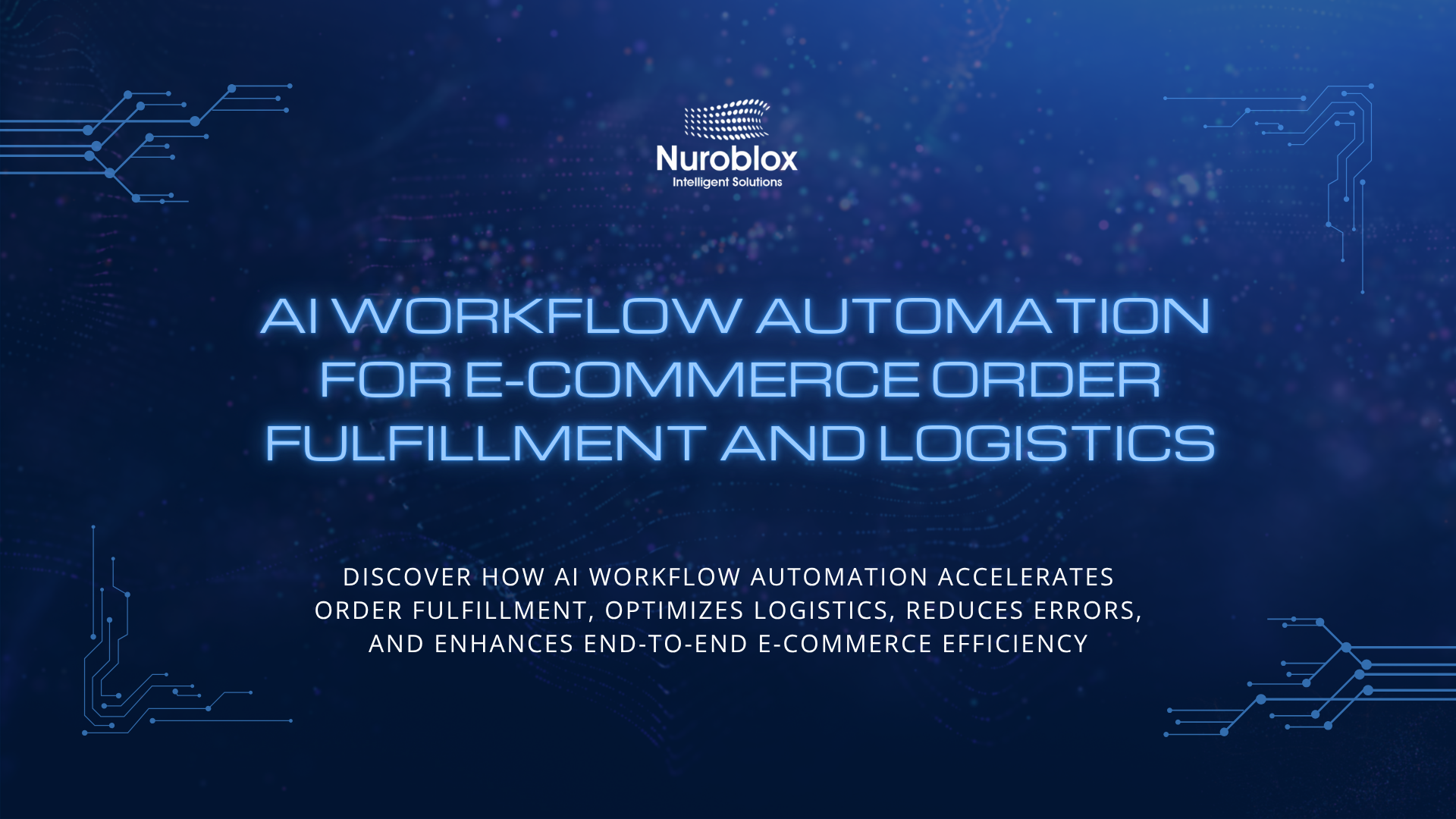AI Workflow Automation for E-commerce Order Fulfillment and Logistics
The e-commerce industry processes billions of orders annually, with consumers expecting faster delivery times and seamless shopping experiences. AI workflow automation for e-commerce has emerged as a game-changing solution that revolutionizes how online retailers manage order fulfillment, inventory, and logistics operations. By integrating artificial intelligence with automated workflows, businesses can reduce processing times by up to 80%, minimize human errors, and scale operations without proportionally increasing operational costs.
Understanding AI Workflow Automation in E-commerce
AI workflow automation for e-commerce combines machine learning algorithms, robotic process automation, and intelligent decision-making systems to streamline end-to-end order fulfillment processes. Unlike traditional automation that follows rigid, rule-based protocols, AI-powered systems learn from data patterns, adapt to changing conditions, and make autonomous decisions that optimize operational efficiency.
Modern e-commerce businesses face complex challenges including multi-channel order management, real-time inventory synchronization, dynamic shipping route optimization, and customer communication across multiple touchpoints. AI workflow automation addresses these challenges by creating intelligent systems that coordinate seamlessly across warehouses, transportation networks, and customer service platforms.
Key Components of AI Workflow Systems
Intelligent process automation forms the foundation by combining traditional automation with cognitive capabilities that understand context and handle exceptions. Machine learning models analyze historical order data to predict demand fluctuations, optimize inventory levels, and prevent stock outs during peak periods. Natural language processing enables automated customer communication, from order confirmation emails to shipping updates and return processing.
Workflow orchestration connects disparate systems including e-commerce platforms, warehouse management systems, transportation management software, and enterprise resource planning tools. This orchestration ensures data flows seamlessly between systems, eliminating manual data entry and reducing the risk of synchronization errors.
Transforming Order Processing with AI Automation
The order-to-shipment cycle represents the most critical workflow in e-commerce operations, where AI workflow automation for e-commerce delivers measurable improvements in speed and accuracy. Traditional order processing involves manual verification, inventory checks, payment confirmation, and warehouse notification-steps that can take hours and introduce multiple error points.
AI-powered order processing systems instantly validate orders upon submission, cross-reference inventory across multiple warehouses, calculate optimal fulfillment locations based on proximity and stock levels, and route orders to the appropriate facility within seconds. Advanced fraud detection algorithms analyze purchasing patterns, payment information, and delivery addresses to flag suspicious orders before they enter the fulfillment pipeline.
Automated Order Routing and Allocation
Smart order routing algorithms consider multiple variables simultaneously including product availability, warehouse capacity, shipping costs, delivery timeframes, and carrier performance metrics. These systems dynamically allocate orders to fulfillment centers that can deliver the fastest service at the lowest cost, automatically adjusting routing rules when disruptions occur.
Split shipment optimization ensures customers receive partial orders quickly while minimizing shipping costs. When items are stocked at different locations, AI algorithms calculate whether combining shipments or sending separate packages provides better customer experience and cost efficiency.
Intelligent Warehouse Management and Fulfillment
Automated inventory management powered by AI transforms how e-commerce businesses track, store, and move products through fulfillment centers. Computer vision systems monitor warehouse operations in real-time, tracking inventory movements, identifying misplaced items, and ensuring picking accuracy.
AI-driven warehouse management systems optimize storage locations based on product velocity, seasonal demand patterns, and order frequency. Fast-moving items are automatically positioned in easily accessible locations, while slower-moving inventory is stored in secondary zones, maximizing warehouse efficiency without manual reorganization.
Robotic Process Automation in Warehouses
Robotic process automation handles repetitive warehouse tasks including picking, packing, labeling, and sorting with remarkable precision. Autonomous mobile robots navigate warehouse floors, transporting products from storage locations to packing stations, while collaborative robots assist human workers with heavy lifting and repetitive tasks.
Pick-to-light and voice-picking systems guided by AI reduce picking errors to less than 0.1% compared to 3-5% error rates with manual picking. These systems adapt to individual worker performance patterns, adjusting instruction pacing and providing real-time feedback to optimize productivity.
AI-Powered Logistics and Shipping Optimization
Transportation represents up to 50% of total logistics costs for e-commerce businesses, making AI logistics automation essential for maintaining competitive margins. AI algorithms analyze vast datasets including historical shipping performance, weather patterns, traffic conditions, carrier capacity, and fuel costs to determine optimal shipping methods for each order.
Dynamic carrier selection systems automatically choose the most cost-effective and reliable shipping option based on current conditions rather than static routing rules. When preferred carriers experience delays or capacity constraints, the system instantly switches to alternative options without requiring manual intervention.
Last-Mile Delivery Optimization
Last-mile delivery represents the most expensive and challenging segment of the fulfillment process, often accounting for 53% of total shipping costs. AI-powered route optimization algorithms process real-time traffic data, delivery windows, driver locations, and package priorities to create efficient delivery routes that minimize travel distance and fuel consumption.
Predictive delivery time windows provide customers with accurate delivery estimates by analyzing historical delivery patterns, current traffic conditions, and driver performance data. These AI systems continuously update delivery estimates as conditions change, automatically notifying customers of delays before they occur.
Intelligent Inventory Management and Demand Forecasting
E-commerce workflow optimization relies heavily on accurate inventory management that balances stock availability with carrying costs. Traditional inventory systems use simple reorder points and safety stock calculations that often result in either stock outs or excess inventory.
AI-powered demand forecasting analyzes hundreds of variables including historical sales data, seasonal trends, marketing campaigns, competitor pricing, economic indicators, and social media sentiment to predict future demand with remarkable accuracy. These systems automatically adjust inventory levels across multiple warehouses, initiating purchase orders and internal transfers to ensure optimal stock distribution.
Multi-Channel Inventory Synchronization
E-commerce businesses selling across multiple platforms face constant challenges maintaining accurate inventory counts. AI workflow automation synchronizes inventory in real-time across online marketplaces, company websites, retail stores, and third-party fulfillment centers, preventing overselling and customer disappointment.
When inventory levels drop below optimal thresholds, automated systems trigger replenishment workflows that consider supplier lead times, minimum order quantities, and seasonal demand patterns. These systems optimize purchasing decisions to minimize costs while ensuring product availability during peak demand periods.
Automated Returns Processing and Reverse Logistics
Returns management represents a significant operational burden, with e-commerce return rates averaging 20-30% across categories. AI-powered supply chain management streamlines returns processing through automated return authorization, intelligent disposition decisions, and optimized reverse logistics workflows.
AI systems analyze return requests to identify patterns indicating product defects, sizing issues, or fraudulent return activity. Automated disposition engines determine whether returned items should be restocked, refurbished, liquidated, or disposed of based on condition, remaining value, and reconditioning costs.
Customer Communication Automation
Intelligent chatbots and virtual assistants handle return inquiries, guide customers through return procedures, and provide instant return label generation without human intervention. Natural language processing capabilities enable these systems to understand customer concerns, offer appropriate solutions, and escalate complex issues to human agents when necessary.
Automated refund processing triggers immediately upon return receipt verification, improving customer satisfaction and reducing the workload on customer service teams. These systems integrate with accounting platforms to ensure accurate financial reconciliation and inventory adjustments.
Real-Time Performance Monitoring and Analytics
Workflow optimization by AI extends beyond task automation to include continuous performance monitoring and improvement. AI-powered analytics platforms track key performance indicators including order processing time, fulfillment accuracy, shipping performance, inventory turnover, and customer satisfaction scores.
Predictive analytics identify potential bottlenecks before they impact operations, enabling proactive intervention. Machine learning algorithms detect anomalies in order patterns, fulfillment times, or quality metrics, automatically alerting managers to investigate potential issues.
Continuous Process Improvement
AI systems learn from every transaction, continuously refining workflows to improve efficiency. A/B testing capabilities allow businesses to experiment with different fulfillment strategies, automatically implementing approaches that deliver superior results.
Automated reporting provides stakeholders with real-time visibility into operations, eliminating manual report generation and ensuring decision-makers have current information. Customizable dashboards present relevant metrics to different roles, from warehouse managers focused on picking efficiency to executives monitoring overall fulfillment costs.

Successful implementation of AI workflow automation for e-commerce requires strategic planning rather than wholesale system replacement. Organizations should begin by identifying high-volume, repetitive processes that consume significant time and resources, such as order entry, inventory updates, or shipment tracking.
No-code automation platforms enable business users to design and deploy automated workflows without extensive programming knowledge, accelerating implementation timelines. These platforms provide pre-built connectors for popular e-commerce platforms, warehouse management systems, and shipping carriers, simplifying integration challenges.
Integration with Existing Systems
Modern intelligent process automation solutions offer flexible integration capabilities that work alongside existing technology investments. API-based integrations connect AI workflow engines with e-commerce platforms like Shopify, WooCommerce, and Magento, as well as enterprise systems including SAP, Oracle, and Microsoft Dynamics.
Cloud-based deployment models eliminate infrastructure concerns while providing scalability to handle seasonal demand fluctuations. Organizations can start with pilot implementations in specific fulfillment centers or product categories, gathering performance data before expanding automation across operations
Conclusion – Future-Proofing E-commerce Operations
AI workflow automation for e-commerce represents more than incremental efficiency improvements—it fundamentally transforms how online retailers compete in an increasingly demanding marketplace . As consumer expectations continue rising and profit margins face pressure, businesses that embrace intelligent process automation gain decisive advantages in speed, accuracy, and scalability .
The technology continues evolving rapidly, with emerging capabilities including autonomous decision-making agents, predictive maintenance for warehouse equipment, and AI-powered demand sensing that anticipates trends before they fully emerge . Organizations investing in automation infrastructure today position themselves to leverage these innovations as they mature .
Ready to transform your e-commerce operations with AI workflow automation? Discover how Nuroblox’s intelligent automation platform can streamline your order fulfillment and logistics processes, reducing costs while delivering exceptional customer experiences.


